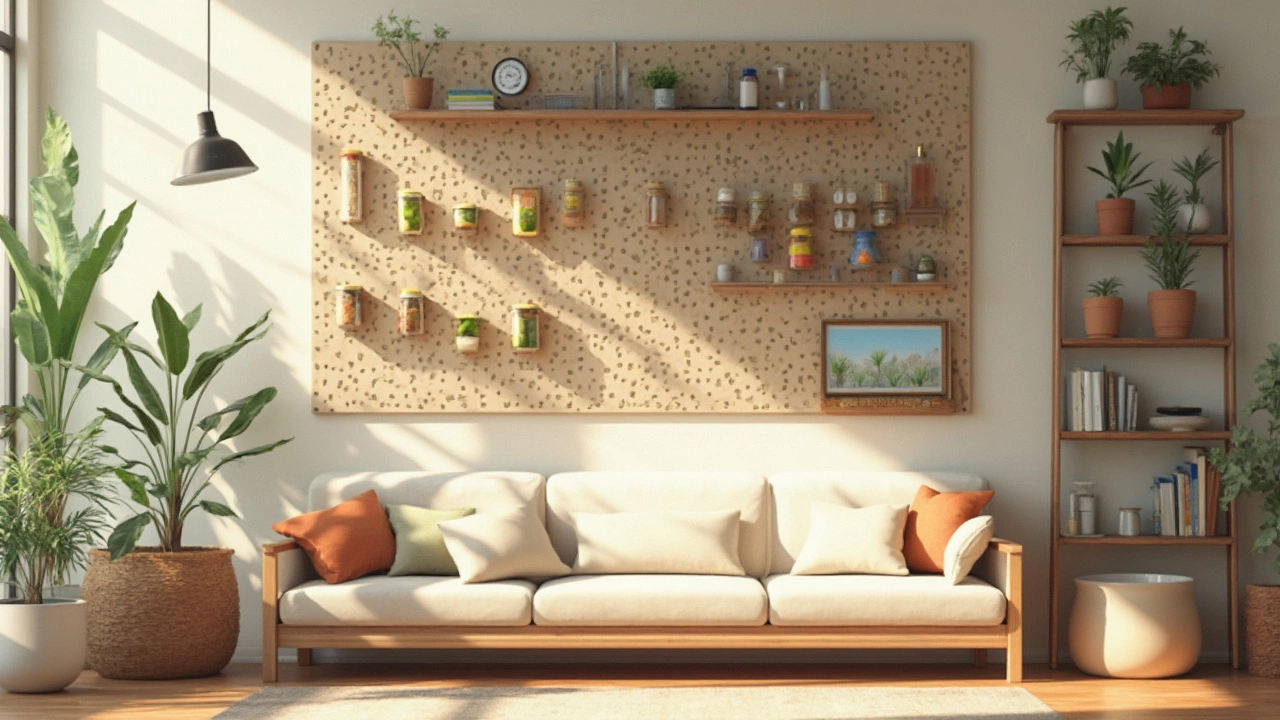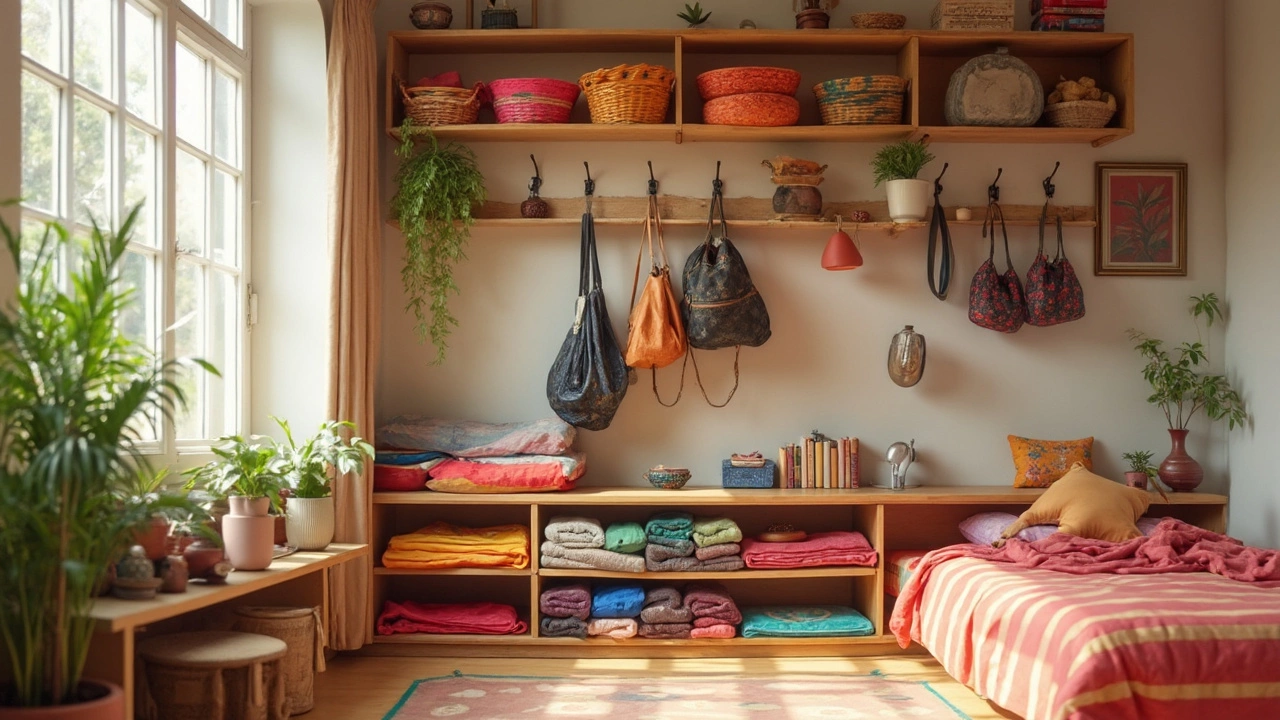If you walk into your home and never know where to drop your bag, you’re not alone. Tons of houses, especially older ones or city apartments, were built before people had so much stuff. Is your “hall closet” just a weird shallow nook? Bedroom stuffed with off-season clothes and spare bedding? Yeah, me too.
The trick isn’t about wishing you had a basement or a walk-in pantry—it’s about using every inch you do have. That starts right now, before you even buy some trendy organizing cube. Let’s zoom in on the stuff itself: Do you still need three blenders? Is last year’s holiday decor just taking room for no reason? Ruthless honesty is the best starting point for any storage struggle, and it’s free.
You don’t have to say goodbye to everything, but you do have to pick your favorites. It’s way easier to store what you actually use, and suddenly the kitchen drawers open all the way and the bedroom feels a little bigger. This article is packed with down-to-earth tips for squeezing the most out of your space, even if it feels like there’s nowhere left to hide a single umbrella.
- Rethink Your Stuff: The Honest Audit
- Hidden Spaces You Forgot About
- Furniture That Works Overtime
- Smart Storage Hacks for Everyday Use
- Staying Organized (Even When Life Gets Messy)
Rethink Your Stuff: The Honest Audit
You can’t fix a storage solutions problem if you’re just shuffling clutter from one corner to another. Step back and try this: look at your stuff like a guest would. It’s easy to get used to piles of shoes by the door or boxes shoved under the bed, but if you want more space, you have to cut down on what’s actually taking up room.
Start with one area—don’t try to tackle the whole house at once or you’ll just get overwhelmed and probably give up. Clear a kitchen drawer, a closet shelf, or one small cabinet. Lay everything out. Ask yourself: When was the last time you used this? Would you buy it again today? Could someone else use it more than you?
It’s wild how much stuff we hang onto for “just in case” or “maybe someday.” A UCLA study found that American families often use just a fraction of the things they store in their garages and attics, with sentimental clutter being the hardest to part with. Here’s a quick way to audit:
- Keep: Used often, makes life easier, or brings actual joy.
- Donate/Sell: Still good, but you don’t use it enough to earn its spot in your house.
- Toss/Recycle: Broken, stained, or just plain done.
Set a timer if you get stuck. Some people swear by taking photos of sentimental stuff before letting go—a digital memory without the physical mess. And if you shriek in horror at tossing anything, try rotating items into storage bins (out of sight for 30 days). If you don’t miss it, it probably doesn’t need to come back.
This honest audit isn’t about minimalism, it’s about making room to actually use your home. Now you’ve trimmed the bulk, finding creative places for what’s left gets a whole lot easier.
Hidden Spaces You Forgot About
So many of us walk around our place and honestly miss the best spots for stash and grab storage. You don’t need secret carpentry skills—just a new way of looking at what you already have. People who make it work in tiny homes or apartments use every weird nook like it’s prime real estate, and you totally can, too.
Some places are basically asking to hold your stuff without crowding you out. Check these out:
- Under the bed: Obvious, but seriously, so underused. Those flat rolling bins or vacuum bags fit right under most frames, and you can toss shoes, sweaters, even luggage down there. Pro tip: Raise your bed by a few inches to double how much you can fit underneath.
- Behind doors: Door hooks aren’t just for jackets. Hang organizers, cleaning supplies, or pantry goods with over-the-door racks—even behind a bathroom door for extra towels or toiletries.
- Above cabinets or the fridge: If your kitchen cabinets stop before the ceiling, that top space can handle baking trays, cereal boxes, or baskets for snacks. It shines in small kitchens where you’re always wishing for another shelf.
- On closet floors: Most folks waste this spot. Stack bins or add a shoe shelf to maximize the base of your closet—no more mystery piles gathering dust.
- Stairs with storage: If you’ve got stairs, look underneath. Some homes come with a closet by the stairwell, but even open stairs can hold baskets or low shelves if you’re short on space elsewhere.
You might be surprised just how much you can actually fit! Check out this quick chart that shows the typical storage volume available in forgotten areas around the house:
| Hidden Space | Typical Storage Volume |
|---|---|
| Under-bed | Up to 16 cu. ft. for a queen-sized bed |
| Above cabinets/fridge | 2-4 cu. ft. per kitchen |
| Behind standard doors | 1-2 cu. ft. per door (using racks) |
| Closet floors | 1-3 cu. ft. per closet |
| Under stairs | Varies, but often 5-10 cu. ft. or more |
When you look for storage solutions, the real magic is using space that’s already in plain sight. Scope out those blank spots, get creative, and clear off your counters without feeling cramped.

Furniture That Works Overtime
The real game-changer in a home with limited storage is what your furniture can do for you. You want every piece to pull double duty—no freeloaders allowed. Think beds with drawers underneath, ottomans that hide blankets, and coffee tables where you can stash games or magazines. If it can’t store something or fold away? It’s not earning its keep.
Here’s what usually stands out for multi-purpose storage solutions—stuff you can find at big stores, online, or even thrifted:
- Storage beds: Drawers under your mattress turn wasted space into real storage for sheets or shoes.
- Sofas with hidden storage: Couch arms and seats that lift up are perfect for tucking away remote controls or spare bedding.
- Lift-top coffee tables: These are a lifesaver in tiny living rooms, giving you a place to work and keep your clutter out of sight.
- Wall-mounted desks: They fold up when you’re done, keeping work gear off the floor.
- Dining benches with storage: Great for stuffing kids’ toys or kitchen gadgets right where you use them.
Check out this quick table showing just how much extra storage space, in cubic feet, you could gain by swapping regular furniture for storage furniture in a small apartment:
| Furniture Type | Standard Version | With Storage | Extra Space Gained |
|---|---|---|---|
| Queen Bed Frame | 0 cu.ft. | 12 cu.ft. | 12 cu.ft. |
| Ottoman | 0 cu.ft. | 3 cu.ft. | 3 cu.ft. |
| Coffee Table | 0 cu.ft. | 2.5 cu.ft. | 2.5 cu.ft. |
| Dining Bench | 0 cu.ft. | 1.2 cu.ft. | 1.2 cu.ft. |
Altogether, a few smart choices free up more than 18 extra cubic feet—enough to store months’ worth of off-season clothes or all your books and hobby gear. The best part? All this storage is right where you already live and sit, so you don’t need to hunt around for it.
One more tip: Look for pieces with clean lines and simple hinges. Complicated designs can break faster (and are a pain to assemble). When your furniture works overtime, your home finally feels bigger—without losing a single inch.
Smart Storage Hacks for Everyday Use
Let’s get real about storage solutions you’ll actually use each day—no power tools, no Pinterest crafts you’ll never finish. The goal is to make it easy to stash stuff without thinking too hard, and to use spots that don’t look like obvious storage.
First up, hooks. Install hooks almost anywhere—on the backs of doors, under kitchen cabinets, inside closets, or even on the side of furniture. It’s wild how much gets picked up off the floor: backpacks, headphones, towels, purses, and even pots and pans. Command hooks work especially well if you’re renting.
- Use stackable bins in your kitchen cabinets so you can double your space. Cube and rectangular bins slide in and out, making it easy to grab snacks or bulk pasta without creating a mess.
- If you have stairs, try putting baskets on the steps to drop things that need to go up or down. It sounds odd, but it works, especially if you have kids who leave a trail of toys or clothes.
- Door organizers aren’t just for shoes—use them in the bathroom for extra products, in the pantry for spices or snacks, or behind a closet door for accessories or hats. A basic over-the-door organizer can clear so much clutter in a small home.
- Stacking clear plastic drawers under beds or sofas is a game changer for storing off-season clothes, extra bedding, or holiday decorations. They keep stuff dust-free and out of sight.
- Got barely any counter space? Magnetic strips on your kitchen wall or inside cabinet doors hold knives, scissors, or even spice jars. This makes everything easy to find and you’ll free up whole drawers.
Don’t forget the old-school basket trick. A big basket in the living room can hide toys, extra blankets, or even shoes. It’s not fancy, but it does the job and stops your stuff from taking over the floor.
And here’s one more thing: any space can be used for storage solutions if you get creative. For example, tension rods under your sink can hold cleaning sprays, or you can line your closet walls with peel-and-stick hooks for small bags. The right hack isn’t the flashiest—it’s the one that saves your sanity every day.

Staying Organized (Even When Life Gets Messy)
Let’s be honest—nobody’s house stays magazine-perfect all the time. Stuff multiplies, hobbies start new piles, and kids or pets just add chaos. But you can keep control, even if real life gets a little wild.
The main thing is habits. When there’s almost zero storage, even a few lazy days can lead to clutter. Experts recommend a quick daily reset: five or ten minutes where everybody tosses things back where they belong. It sounds small, but it legit works. One study from the National Association of Productivity & Organizing Professionals found that 82% of people who organized for just 10 minutes a day felt less stressed in their homes. Less mess, less stress.
Here’s what helps:
- Storage solutions should fit your actual routine—if the kids never hang up backpacks, try a basket by the door instead of a hook.
- Limit “problem zone” drop spots. Keep a small tray or bin for things like mail or keys, and empty it once a week.
- Make it a game: Set a timer and challenge the house to reset faster than yesterday. Small rewards work for grown-ups, too.
- Have “outbox” baskets in closets for clothes or items that are on their way out. Drop stuff in as you come across it, not once a year.
- Rotate seasonal things. Don’t let winter boots or swim gear choke up your main space. Stash them out of sight in clear, labeled containers and swap out twice a year.
It’s easy to think you need more baskets or trendy bins. Sometimes, just cutting down the number of things that get left out can shrink messes instantly. If you lose track of how much space you’re saving, tracking it helps—see the table below for quick ways to measure progress.
| Quick Action | Average Space Saved | Time to Complete |
|---|---|---|
| Daily 10-min reset | Up to 50 sq. ft. free of random items (living room/bedroom) | 10 minutes |
| Monthly outbox cleanout | 1-2 bags of stuff removed | 20 minutes |
| Seasonal swap | Major shelf or closet uncluttered | 30-45 minutes |
The goal isn’t perfection—it’s making sure your space works for you, not against you. And when mess sneaks in, you’ve got a game plan to handle it quickly, no guilt needed.
